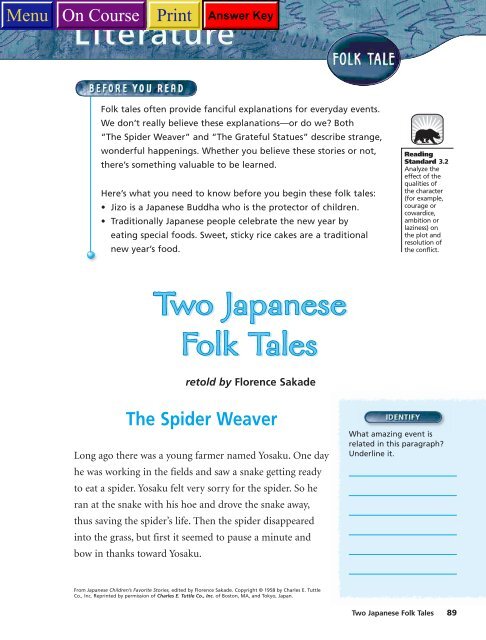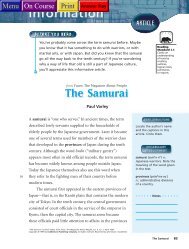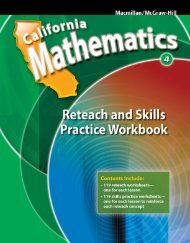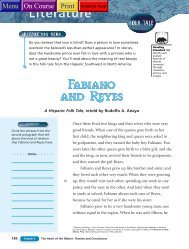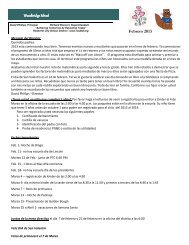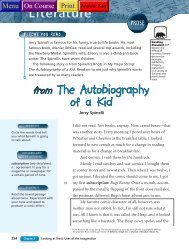Create successful ePaper yourself
Turn your PDF publications into a flip-book with our unique Google optimized e-Paper software.
Folk tales often provide fanciful explanations for everyday events.<br />
We don’t really believe these explanations—or do we? Both<br />
“<strong>The</strong> <strong>Spider</strong> <strong>Weaver</strong>” and “<strong>The</strong> Grateful Statues” describe strange,<br />
wonderful happenings. Whether you believe these stories or not,<br />
there’s something valuable to be learned.<br />
Here’s what you need to know before you begin these folk tales:<br />
• Jizo is a Japanese Buddha who is the protector of children.<br />
• Traditionally Japanese people celebrate the new year by<br />
eating special foods. Sweet, sticky rice cakes are a traditional<br />
new year’s food.<br />
retold by Florence Sakade<br />
<strong>The</strong> <strong>Spider</strong> <strong>Weaver</strong><br />
Long ago there was a young farmer named Yosaku. One day<br />
he was working in the fields and saw a snake getting ready<br />
to eat a spider. Yosaku felt very sorry for the spider. So he<br />
ran at the snake with his hoe and drove the snake away,<br />
thus saving the spider’s life. <strong>The</strong>n the spider disappeared<br />
into the grass, but first it seemed to pause a minute and<br />
bow in thanks toward Yosaku.<br />
From Japanese Children’s Favorite Stories, edited by Florence Sakade. Copyright © 1958 by Charles E. Tuttle<br />
Co., Inc. Reprinted by permission of Charles E. Tuttle Co., Inc. of Boston, MA, and Tokyo, Japan.<br />
Reading<br />
Standard 3.2<br />
Analyze the<br />
effect of the<br />
qualities of<br />
the character<br />
(for example,<br />
courage or<br />
cowardice,<br />
ambition or<br />
laziness) on<br />
the plot and<br />
resolution of<br />
the conflict.<br />
What amazing event is<br />
related in this paragraph?<br />
Underline it.<br />
Two Japanese Folk Tales 89
In many folk tales a person<br />
is helped or promised something,<br />
but on some condition.<br />
What rule does the girl<br />
say Yosaku must obey?<br />
Underline it.<br />
Why is Yosaku’s curiosity<br />
aroused by the girl’s response<br />
to his question? What does<br />
he do about it?<br />
Like many folk tales, this one<br />
includes a metamorphosis<br />
(met •¥ •môr√f¥ •sis), a<br />
marvelous change from<br />
one form to another. Circle<br />
the description of a metamorphosis.<br />
Why did the spider take a<br />
human form? Underline the<br />
passage that tells you why.<br />
90 Chapter 2 Characters: <strong>The</strong> People You’ll Meet<br />
10<br />
20<br />
30<br />
One morning not long after that, Yosaku was in his<br />
house when he heard a tiny voice outside calling: “Mr.<br />
Yosaku, Mr. Yosaku.” He went to the door and saw a<br />
beautiful young girl standing in the yard.<br />
“I heard that you are looking for someone to weave<br />
cloth for you,” said the girl. “Won’t you please let me live<br />
here and weave for you?”<br />
Yosaku was very pleased because he did need a weaving<br />
girl. So he showed the girl the weaving room and she<br />
started to work at the loom. At the end of the day Yosaku<br />
went to see what she’d done and was very surprised to find<br />
that she’d woven eight long pieces of cloth, enough to make<br />
eight kimonos. He’d never known anyone could weave so<br />
much in just a single day.<br />
“How ever did you weave so much?” he asked the girl.<br />
But instead of answering him, she said a very strange<br />
thing: “You mustn’t ask me that. And you must never come<br />
into the weaving room while I am at work.”<br />
But Yosaku was very curious. So one day he slipped<br />
very quietly up to the weaving room and peeped in the<br />
window. What he saw really surprised him! Because it was<br />
not the girl who was seated at the loom, but a large spider,<br />
weaving very fast with its eight legs, and for thread it was<br />
using its own spider web, which came out of its mouth.<br />
Yosaku looked very closely and saw that it was the<br />
same spider which he’d saved from the snake. <strong>The</strong>n Yosaku<br />
understood. <strong>The</strong> spider had been so thankful that it had<br />
wanted to do something to help Yosaku. So it had turned<br />
itself into a beautiful young girl and come to weave cloth<br />
for him. Just by eating the cotton in the weaving room it<br />
could spin it into thread inside its own body, and then with
40<br />
50<br />
60<br />
70<br />
its eight legs it could weave the thread into cloth very,<br />
very fast.<br />
Yosaku was very grateful for the spider’s help. He saw<br />
that the cotton was almost used up. So next morning he set<br />
out for the nearest village, on the other side of the mountains,<br />
to buy some more cotton. He bought a big bundle of<br />
cotton and started home, carrying it on his back.<br />
Along the way a very terrible thing happened. Yosaku<br />
sat down to rest, and the same snake that he’d driven away<br />
from the spider came up and slipped inside the bundle of<br />
cotton. But Yosaku didn’t know anything about this. So he<br />
carried the cotton home and gave it to the weaving girl.<br />
She was very glad to get the cotton, because she’d now<br />
used up all the cotton that was left. So she took it and went<br />
to the weaving room.<br />
As soon as the girl was inside the weaving room, she<br />
turned back into a spider and began eating the cotton very,<br />
very fast, just as though it were something very delicious,<br />
so she could spin it into thread inside her body. <strong>The</strong> spider<br />
ate and ate and ate, and then suddenly, when it had eaten<br />
down to the bottom of the bundle—the snake jumped out<br />
of the cotton. It opened its mouth wide to swallow the<br />
spider. <strong>The</strong> spider was very frightened and jumped out<br />
of the window. <strong>The</strong> snake went wriggling very fast after it.<br />
And the spider had eaten so much cotton that it couldn’t<br />
run very fast. So the snake gradually caught up with the<br />
spider. Again the snake opened its mouth wide to gulp the<br />
spider down. But just then a wonderful thing happened.<br />
Old Man Sun, up in the sky, had been watching what<br />
was happening. He knew how kind the spider had been to<br />
Yosaku and he felt very sorry for the poor little spider. So<br />
he reached down with a sunbeam and caught hold of the<br />
Pause at line 50. What new<br />
problem has come up?<br />
Underline it.<br />
Read aloud the boxed passage.<br />
As you read, vary your<br />
volume, rate of speech, and<br />
pitch to help your listeners<br />
feel the scene’s excitement.<br />
<strong>The</strong>n, re-read the passage to<br />
improve the smoothness of<br />
your delivery.<br />
• • • • • • Notes • • • • • •<br />
Two Japanese Folk Tales 91
Why did Old Man Sun save<br />
the spider?<br />
What natural feature of<br />
our world is explained in the<br />
story?<br />
Underline words in lines 1–10<br />
that describe the old man.<br />
Circle passages that tell what<br />
he wants. Box passages that<br />
tell what he does.<br />
• • • • • • Notes • • • • • •<br />
92 Chapter 2 Characters: <strong>The</strong> People You’ll Meet<br />
80<br />
10<br />
end of the web that was sticking out of the spider’s mouth,<br />
and he lifted the spider high up into the sky, where the<br />
snake couldn’t reach it at all.<br />
<strong>The</strong> spider was very grateful to Old Man Sun for<br />
saving him from the snake. So he used all the cotton that<br />
was inside his body to weave beautiful fleecy clouds up<br />
in the sky. That’s the reason, they say, why clouds are soft<br />
and white like cotton, and also that is the reason why<br />
both a spider and a cloud are called by the same name<br />
in Japan—kumo.<br />
“Fine Wind, Clear Morning,” hand-colored woodblock print<br />
by Katsushika Hokusai, 1831.<br />
<strong>The</strong> Grateful Statues<br />
Once upon a time an old man and an old woman were living<br />
in a country village in Japan. <strong>The</strong>y were very poor and<br />
spent every day weaving big hats out of straw. Whenever<br />
they finished a number of hats, the old man would take<br />
them to the nearest town to sell them.<br />
One day the old man said to the old woman: “New<br />
Year’s is the day after tomorrow. How I wish we had some<br />
rice cakes to eat on New Year’s Day! Even one or two little<br />
cakes would be enough. Without some rice cakes we can’t<br />
even celebrate New Year’s.”
20<br />
30<br />
40<br />
“Well, then,” said the old woman, “after you’ve sold<br />
these hats, why don’t you buy some rice cakes and bring<br />
them back with you?”<br />
So early the next morning the old man took the<br />
five new hats that they had made, and went to town to<br />
sell them. But after he got to town, he was unable to sell<br />
a single hat. And to make things still worse, it began to<br />
snow very hard.<br />
<strong>The</strong> old man was very sad as he began trudging wearily<br />
back toward his village. He was going along a lonesome<br />
mountain trail when he suddenly came upon a row of six<br />
stone statues of Jizo, the protector of children, all covered<br />
with snow.<br />
“My, my! Now isn’t this a pity,” the old man said.<br />
“<strong>The</strong>se are only stone statues of Jizo, but even so just think<br />
how cold they must be standing here in the snow.”<br />
“I know what I’ll do!” the old man suddenly said to<br />
himself. “This will be just the thing.”<br />
So he unfastened the five new hats from his back and<br />
began tying them, one by one, on the heads of the Jizo<br />
statues.<br />
When he came to the last statue, he suddenly realized<br />
that all the hats were gone. “Oh, my!” he said, “I don’t have<br />
enough hats.” But then he remembered his own hat. So he<br />
took it off his head and tied it on the head of the last Jizo.<br />
<strong>The</strong>n he went on his way home.<br />
When he reached his house, the old woman was waiting<br />
for him by the fire. She took one look at him and cried:<br />
“You must be frozen half to death. Quick! Come to the fire.<br />
What did you do with your hat?”<br />
<strong>The</strong> old man shook the snow out of his hair and came<br />
to the fire. He told the old woman how he had given all the<br />
Pause at line 36. Box the<br />
passage that tells what the<br />
old man does for the statues.<br />
What do the old man’s<br />
actions reveal about his<br />
character?<br />
Two Japanese Folk Tales 93
Circle what the old woman<br />
says to the old man. What<br />
does her reaction tell you<br />
about her character?<br />
Pause at line 53. What “very<br />
wonderful thing” might<br />
happen?<br />
How are the old man and<br />
the old woman rewarded<br />
for their actions?<br />
94 Chapter 2 Characters: <strong>The</strong> People You’ll Meet<br />
50<br />
60<br />
70<br />
new hats, and even his own hat, to the six stone Jizo. He<br />
told her he was sorry that he hadn’t been able to bring any<br />
rice cakes.<br />
“My! That was a very kind thing you did for the Jizo,”<br />
said the old woman. She was very proud of the old man,<br />
and went on: “It’s better to do a kind thing like that than to<br />
have all the rice cakes in the world. We’ll get along without<br />
any rice cakes for New Year’s.”<br />
By this time it was late at night, so the old man and<br />
woman went to bed. And just before dawn, while they were<br />
still asleep, a very wonderful thing happened. Suddenly<br />
there was the sound of voices in the distance, singing:<br />
“A kind old man walking in the snow<br />
Gave all his hats to the stone Jizo.<br />
So we bring him gifts with a yo-heave-ho!”<br />
<strong>The</strong> voices came nearer and nearer, and then you could<br />
hear the sound of footsteps on the snow.<br />
<strong>The</strong> sounds came right up to the house where the old<br />
man and woman were sleeping. And then all at once there<br />
was a great noise, as though something had been put down<br />
just in front of the house.<br />
<strong>The</strong> old couple jumped out of bed and ran to the front<br />
door. When they opened it, what do you suppose they<br />
found? Well, right there at the door someone had spread a<br />
straw mat, and arranged very neatly on the mat was one of<br />
the biggest and most beautiful and freshest rice cakes the<br />
old people had ever seen.<br />
“Whoever could have brought us such a wonderful<br />
gift?” they said, and looked about wonderingly.
80<br />
<strong>The</strong>y saw some tracks in the snow leading away from<br />
their house. <strong>The</strong> snow was all tinted with the colors of<br />
dawn, and there in the distance, walking over the snow,<br />
were the six stone Jizo, still wearing the hats which the old<br />
man had given them.<br />
<strong>The</strong> old man said: “It was the stone Jizo who brought<br />
this wonderful rice cake to us.”<br />
<strong>The</strong> old woman said: “You did them a kind favor when<br />
you gave them your hats, so they brought this rice cake to<br />
show their gratitude.”<br />
<strong>The</strong> old couple had a very wonderful New Year’s Day<br />
celebration after all, because now they had this wonderful<br />
rice cake to eat.<br />
What would you say is the<br />
“lesson” of this folk tale?<br />
Compare this lesson to<br />
the lesson in “<strong>The</strong> <strong>Spider</strong><br />
<strong>Weaver</strong>.”<br />
Two Japanese Folk Tales 95
Comparing Characters and Events Complete the Venn diagram<br />
below. Show how the characters and events in the two folk tales are<br />
the same and how they are different. <strong>The</strong>n, share your work with a<br />
partner, and comment on each other’s work.<br />
Personal Word List Record this academic term in your Personal<br />
Word List: metamorphosis.<br />
<strong>The</strong> <strong>Spider</strong><br />
<strong>Weaver</strong><br />
Personal Reading Log As you add this selection to your Personal<br />
Reading Log, indicate whether you would like to read more Japanese<br />
folk tales. Give yourself 3 points on the Reading Meter.<br />
Checklist for Standards Mastery Use the Checklist for Standards<br />
Mastery to see how much you have learned.<br />
96 Chapter 2 Characters: <strong>The</strong> People You’ll Meet<br />
Both<br />
<strong>The</strong> Grateful<br />
Statues
Two Japanese Folk Tales Interactive Reading, page 89<br />
Go Beyond Literary Texts<br />
Story Map <strong>The</strong> folk tales you have read have a great deal in common.<br />
Both folk tales are about ordinary people who do kind deeds and<br />
receive great rewards for their actions. Both folk tales contain strong<br />
moral messages about the kind of people we should all try to be.<br />
Tell a “folk tale” of your own. Include some of these characteristics<br />
of a folk tale:<br />
•characters who want<br />
something very much<br />
•supernatural characters<br />
•a moral lesson<br />
Before you write your folk tale, gather your details in a story map<br />
like the one that follows:<br />
Moral:<br />
Characters<br />
•a condition or test<br />
• an explanation of how something<br />
in our world came to be<br />
•a marvelous metamorphosis<br />
What characters want<br />
Why they can’t get it<br />
Resolution<br />
Setting<br />
Event 1:<br />
What happens<br />
Event 2: Event 3 (and so on):<br />
Graphic Organizer 97
DIFFERENTIATING INSTRUCTION<br />
Two Japanese Folk Tales<br />
■ Learners Having Difficulty<br />
<strong>The</strong>se folk tales are appropriate<br />
for the struggling reader.<br />
You may wish to model the<br />
reading strategy for them<br />
before they begin to read.<br />
■ Benchmark Students<br />
Encourage on-level learners to<br />
make connections between<br />
these tales and other folk tales<br />
they have read from other<br />
cultures.<br />
■ Advanced Students<br />
Advanced readers will have no<br />
difficulties with these folk<br />
tales. You may wish to have<br />
these students extend their<br />
reading by citing examples of<br />
folk tales from other cultures<br />
that impart the same lessons<br />
as these two Japanese folk<br />
tales.<br />
TEACHER TO TEACHER<br />
Students will enjoy the transformation<br />
in the first story, as the<br />
spider becomes the beautiful<br />
young weaver. <strong>The</strong>y will also like<br />
the second story, in which the<br />
statues come alive. As a class,<br />
discuss ways in which these<br />
transformations might be portrayed<br />
onstage with live actors,<br />
stage effects, and technology.<br />
READING OPTION<br />
Folk tales are usually dramatic,<br />
so this selection is ideal for<br />
classroom performance. You<br />
may wish to perform the stories<br />
as improvisations or staged<br />
readings or to try using a theater<br />
game such as “Paper Bag<br />
<strong>The</strong>ater,” an improvisational<br />
technique in which small groups<br />
of students are given paper bags<br />
filled with small everyday<br />
objects to use as props.<br />
22 Interactive Reading: Teacher’s Edition<br />
Two Japanese Folk Tales<br />
retold by Florence Sakade ■ page 89<br />
■ Tell students that they are going to read two Japanese folk tales.<br />
Make sure students understand that a folk tale is a story that has its<br />
origins in a particular culture and is handed down from generation<br />
to generation.<br />
■ Have students read the Before You Read note. As a class, explore<br />
how folk tales often depart from reality to include fantastic elements<br />
such as talking spiders, statues that come alive, and other<br />
transformations and improbable feats. Invite students to predict<br />
what they think will happen in these two tales.<br />
■ Read the first paragraph of the first folk tale aloud; then go on to<br />
read the Identify note aloud.<br />
■ After students identify the amazing event of a spider bowing to a<br />
human being in thanks, ask them to speculate what this story<br />
detail may indicate, thinking about other folk tales they have read.<br />
■ Have students read the rest of the first folk tale and the second<br />
folk tale on their own, noting their responses to the side-column<br />
questions.<br />
■ After students have finished each tale, have them take turns reading<br />
it aloud and sharing their responses.<br />
■ Read the Fluency note aloud. Have volunteers read aloud with<br />
expression, making use of the short, terse sentences to create a<br />
sense of excitement.<br />
■ Have students add these folk tales to their Personal Reading Logs.<br />
■ Students can compare the characters in the two folk tales by completing<br />
the Venn diagram on Interactive Reading page 96.<br />
■ Have students complete the Story Map project on Interactive<br />
Reading page 97 to review the characters in the folk tales and how<br />
their actions and character traits influenced the plot and outcome<br />
of each tale.<br />
■ Use the Comprehension Check on Teacher’s Edition page 29 to<br />
evaluate mastery of the literary standard.
Copyright © by Holt, Rinehart and Winston. All rights reserved.<br />
Name ______________________________ Class _____________ Date _____________<br />
Two Japanese Folk Tales<br />
■ Interactive Reading, page 89<br />
Reading Standard 3.2 Analyze the effect of the qualities of the<br />
character on the plot and resolution of the conflict.<br />
hero<br />
metamorphosis<br />
moral<br />
Academic Vocabulary<br />
Comprehension Check<br />
major character in a story who shows qualities we admire<br />
marvelous change from one form to another<br />
lesson taught in a fable or folk tale<br />
A. Circle the letter of the correct response to each item below.<br />
1. What event in “<strong>The</strong> <strong>Spider</strong> Woman” helps readers see that the<br />
spider is grateful?<br />
A <strong>The</strong> spider bows to Yosaku.<br />
B <strong>The</strong> spider brings Yosaku a bale of cotton.<br />
C <strong>The</strong> spider makes the sun shine on Yosaku’s farm.<br />
D <strong>The</strong> spider brings rice cakes to Yosaku.<br />
2. What metamorphosis occurs in “<strong>The</strong> <strong>Spider</strong> <strong>Weaver</strong>”?<br />
F <strong>The</strong> weaver turns into Old Man Sun.<br />
G <strong>The</strong> spider turns into a statue.<br />
H <strong>The</strong> statues come alive.<br />
J <strong>The</strong> spider changes into a beautiful young woman.<br />
3. Why is the old man the hero of “<strong>The</strong> Grateful Statues”?<br />
A He is clever. C He is loyal and hard working.<br />
B He is kind and self-sacrificing. D He is lucky.<br />
4. What is the moral of “<strong>The</strong> Grateful Statues”?<br />
F People have the ability to be good.<br />
G Don’t judge someone by his or her looks.<br />
H <strong>Spider</strong>s are helpful creatures.<br />
J Goodness is rewarded.<br />
B. Suppose the old couple from “<strong>The</strong> Grateful Statues” was selfish instead of<br />
generous. What might have happened then? Write a new ending for the story.<br />
Chapter 2 29
Chapter 2<br />
Practice Read: Sparring<br />
Vocabulary Check, page 23<br />
A: 1. neutral<br />
2. karate<br />
3. glowering<br />
4. samurai<br />
5. solution<br />
B: Sentences will vary, but should show an understanding<br />
of the meanings of the words.<br />
Comprehension Check, page 24<br />
A: 1. A<br />
2. F<br />
3. D<br />
4. H<br />
B: Answers will vary. Strong answers will cite specific<br />
details from the story.<br />
Foreigner in Japan<br />
Vocabulary Check, page 25<br />
A: 1. mosquito<br />
2. gong<br />
3. saunter<br />
4. bouillon<br />
5. turmoil<br />
6. belied<br />
7. kimono<br />
B: 1. bunches of cut flowers<br />
2. large room for gathering together<br />
3. stir-fried Japanese food dish, prepared<br />
tableside<br />
Comprehension Check, page 26<br />
A: 1. C<br />
2. H<br />
3. D<br />
4. H<br />
B: Answers will vary. A rebellious or insecure or<br />
narrow-minded Yoshiko would not have<br />
accepted her dual heritage so wisely.<br />
<strong>The</strong> Samurai<br />
Vocabulary Check, page 27<br />
A: 1. provinces<br />
2. tumultuous<br />
3. samurai<br />
4. shogun<br />
5. frontier<br />
B: 1. shogun<br />
2. shogunate<br />
3. samurai<br />
Comprehension Check, page 28<br />
A: 1. B<br />
2. H<br />
3. B<br />
B: Answers will vary. Strong answers will state who<br />
they would choose to live as and will provide an<br />
explanation for their choice.<br />
Two Japanese Folk Tales<br />
Comprehension Check, page 29<br />
A: 1. A<br />
2. J<br />
3. B<br />
4. J<br />
B: Answers will vary. A good answer would explain<br />
how the couple would have been punished,<br />
instead of rewarded, for their behavior.<br />
Answer Key 111
<strong>The</strong> Samurai Interactive Reading, page 83<br />
Go Beyond an Informational Text<br />
Folk tales often provide fanciful explanations for everyday events.<br />
We don’t really believe these explanations—or do we? Both<br />
“<strong>The</strong> <strong>Spider</strong> <strong>Weaver</strong>” and “<strong>The</strong> Grateful Statues” describe strange,<br />
wonderful happenings. Whether you believe these stories or not,<br />
Research Template <strong>The</strong> samurai of long ago provide a fascinating<br />
topic for research. Use the template below to learn more about these<br />
warriors of feudal Japan.<br />
164 Interactive Reading: Teacher’s Edition<br />
Project Samurai<br />
Reading<br />
Standard 3.2<br />
Analyze the<br />
effect of the<br />
qualities of<br />
the character<br />
(for example,<br />
courage or<br />
cowardice,<br />
ambition or<br />
laziness) on<br />
the plot and<br />
resolution of<br />
the conflict.<br />
there’s something valuable to be learned.<br />
Questions for Research Resource<br />
Here’s what you need to know before you begin these folk tales:<br />
• Jizo is a Japanese Buddha who is the protector of children.<br />
• Traditionally Japanese people celebrate the new year by<br />
eating special foods. Sweet, sticky rice cakes are a traditional<br />
Who were the samurai?<br />
new year’s food.<br />
When did they live?<br />
What was their purpose?<br />
retold by Florence Sakade<br />
<strong>The</strong> <strong>Spider</strong> <strong>Weaver</strong><br />
What amazing event is<br />
related in this paragraph?<br />
Underline it.<br />
<strong>The</strong> spider bows in<br />
Why were they so feared?<br />
thanks to Yosaku.<br />
Long ago there was a young farmer named Yosaku. One day<br />
he was working in the fields and saw a snake getting ready<br />
to eat a spider. Yosaku felt very sorry for the spider. So he<br />
ran at the snake with his hoe and drove the snake away,<br />
thus saving the spider’s life. <strong>The</strong>n the spider disappeared<br />
into the grass, but first it seemed to pause a minute and<br />
Why did they cease to exist?<br />
Chapter 2<br />
Pupil Pages 56–97<br />
bow in thanks toward Yosaku.<br />
From Japanese Children’s Favorite Stories, edited by Florence Sakade. Copyright © 1958 by Charles E. Tuttle<br />
Co., Inc. Reprinted by permission of Charles E. Tuttle Co., Inc. of Boston, MA, and Tokyo, Japan.<br />
Two Japanese Folk Tales 89<br />
88 Chapter 2 Characters: <strong>The</strong> People You’ll Meet
Pause at line 50. What new<br />
problem has come up?<br />
Underline it.<br />
its eight legs it could weave the thread into cloth very,<br />
very fast.<br />
Yosaku was very grateful for the spider’s help. He saw<br />
that the cotton was almost used up. So next morning he set<br />
out for the nearest village, on the other side of the mountains,<br />
to buy some more cotton. He bought a big bundle of<br />
cotton and started home, carrying it on his back.<br />
Along the way a very terrible thing happened. Yosaku<br />
sat down to rest, and the same snake that he’d driven away<br />
from the spider came up and slipped inside the bundle of<br />
cotton. But Yosaku didn’t know anything about this. So he<br />
carried the cotton home and gave it to the weaving girl.<br />
She was very glad to get the cotton, because she’d now<br />
used up all the cotton that was left. So she took it and went<br />
to the weaving room.<br />
As soon as the girl was inside the weaving room, she<br />
turned back into a spider and began eating the cotton very,<br />
very fast, just as though it were something very delicious,<br />
so she could spin it into thread inside her body. <strong>The</strong> spider<br />
ate and ate and ate, and then suddenly, when it had eaten<br />
down to the bottom of the bundle—the snake jumped out<br />
of the cotton. It opened its mouth wide to swallow the<br />
spider. <strong>The</strong> spider was very frightened and jumped out<br />
of the window. <strong>The</strong> snake went wriggling very fast after it.<br />
And the spider had eaten so much cotton that it couldn’t<br />
run very fast. So the snake gradually caught up with the<br />
spider. Again the snake opened its mouth wide to gulp the<br />
spider down. But just then a wonderful thing happened.<br />
Old Man Sun, up in the sky, had been watching what<br />
was happening. He knew how kind the spider had been to<br />
Yosaku and he felt very sorry for the poor little spider. So<br />
he reached down with a sunbeam and caught hold of the<br />
40<br />
One morning not long after that, Yosaku was in his<br />
house when he heard a tiny voice outside calling: “Mr.<br />
Yosaku, Mr. Yosaku.” He went to the door and saw a<br />
beautiful young girl standing in the yard.<br />
10<br />
In many folk tales a person<br />
is helped or promised something,<br />
but on some condition.<br />
What rule does the girl<br />
say Yosaku must obey?<br />
Underline it.<br />
“I heard that you are looking for someone to weave<br />
cloth for you,” said the girl. “Won’t you please let me live<br />
Read aloud the boxed passage.<br />
As you read, vary your<br />
volume, rate of speech, and<br />
pitch to help your listeners<br />
feel the scene’s excitement.<br />
<strong>The</strong>n, re-read the passage to<br />
improve the smoothness of<br />
your delivery.<br />
50<br />
• • • • • • Notes • • • • • •<br />
here and weave for you?”<br />
Yosaku was very pleased because he did need a weaving<br />
girl. So he showed the girl the weaving room and she<br />
started to work at the loom. At the end of the day Yosaku<br />
went to see what she’d done and was very surprised to find<br />
that she’d woven eight long pieces of cloth, enough to make<br />
eight kimonos. He’d never known anyone could weave so<br />
much in just a single day.<br />
“How ever did you weave so much?” he asked the girl.<br />
But instead of answering him, she said a very strange<br />
thing: “You mustn’t ask me that. And you must never come<br />
into the weaving room while I am at work.”<br />
But Yosaku was very curious. So one day he slipped<br />
very quietly up to the weaving room and peeped in the<br />
window. What he saw really surprised him! Because it was<br />
not the girl who was seated at the loom, but a large spider,<br />
weaving very fast with its eight legs, and for thread it was<br />
using its own spider web, which came out of its mouth.<br />
Yosaku looked very closely and saw that it was the<br />
same spider which he’d saved from the snake. <strong>The</strong>n Yosaku<br />
understood. <strong>The</strong> spider had been so thankful that it had<br />
wanted to do something to help Yosaku. So it had turned<br />
itself into a beautiful young girl and come to weave cloth<br />
for him. Just by eating the cotton in the weaving room it<br />
could spin it into thread inside its own body, and then with<br />
Why is Yosaku’s curiosity<br />
aroused by the girl’s response<br />
to his question? What does<br />
he do about it?<br />
He is curious because<br />
he doesn’t understand<br />
20<br />
why he can never<br />
see her at work.<br />
He disobeys the rule<br />
and looks to see<br />
what she is doing.<br />
60<br />
30<br />
Like many folk tales, this one<br />
includes a metamorphosis<br />
(met •¥ •môr√f¥ •sis), a<br />
marvelous change from<br />
one form to another. Circle<br />
the description of a metamorphosis.<br />
Chapter 2<br />
Pupil Pages 56–97<br />
70<br />
Why did the spider take a<br />
human form? Underline the<br />
passage that tells you why.<br />
Pupil Pages with Answers 165<br />
Two Japanese Folk Tales 91<br />
90 Chapter 2 Characters: <strong>The</strong> People You’ll Meet
“Well, then,” said the old woman, “after you’ve sold<br />
these hats, why don’t you buy some rice cakes and bring<br />
Pause at line 36. Box the<br />
passage that tells what the<br />
old man does for the statues.<br />
What do the old man’s<br />
actions reveal about his<br />
character?<br />
He is kind, thoughtful,<br />
them back with you?”<br />
So early the next morning the old man took the<br />
five new hats that they had made, and went to town to<br />
sell them. But after he got to town, he was unable to sell<br />
166 Interactive Reading: Teacher’s Edition<br />
and unselfish.<br />
end of the web that was sticking out of the spider’s mouth,<br />
and he lifted the spider high up into the sky, where the<br />
snake couldn’t reach it at all.<br />
<strong>The</strong> spider was very grateful to Old Man Sun for<br />
saving him from the snake. So he used all the cotton that<br />
was inside his body to weave beautiful fleecy clouds up<br />
in the sky. That’s the reason, they say, why clouds are soft<br />
and white like cotton, and also that is the reason why<br />
both a spider and a cloud are called by the same name<br />
in Japan—kumo.<br />
Why did Old Man Sun save<br />
the spider?<br />
He knew how kind the<br />
spider had been.<br />
a single hat. And to make things still worse, it began to<br />
snow very hard.<br />
<strong>The</strong> old man was very sad as he began trudging wearily<br />
back toward his village. He was going along a lonesome<br />
mountain trail when he suddenly came upon a row of six<br />
stone statues of Jizo, the protector of children, all covered<br />
with snow.<br />
“My, my! Now isn’t this a pity,” the old man said.<br />
“<strong>The</strong>se are only stone statues of Jizo, but even so just think<br />
how cold they must be standing here in the snow.”<br />
“I know what I’ll do!” the old man suddenly said to<br />
himself. “This will be just the thing.”<br />
So he unfastened the five new hats from his back and<br />
began tying them, one by one, on the heads of the Jizo<br />
statues.<br />
When he came to the last statue, he suddenly realized<br />
that all the hats were gone. “Oh, my!” he said, “I don’t have<br />
enough hats.” But then he remembered his own hat. So he<br />
took it off his head and tied it on the head of the last Jizo.<br />
<strong>The</strong>n he went on his way home.<br />
When he reached his house, the old woman was waiting<br />
for him by the fire. She took one look at him and cried:<br />
“You must be frozen half to death. Quick! Come to the fire.<br />
What did you do with your hat?”<br />
<strong>The</strong> old man shook the snow out of his hair and came<br />
to the fire. He told the old woman how he had given all the<br />
20<br />
80<br />
What natural feature of<br />
our world is explained in the<br />
story?<br />
Why clouds are fleecy,<br />
and why spiders and<br />
clouds are called kumo<br />
“Fine Wind, Clear Morning,” hand-colored woodblock print<br />
by Katsushika Hokusai, 1831.<br />
30<br />
<strong>The</strong> Grateful Statues<br />
40<br />
Once upon a time an old man and an old woman were living<br />
in a country village in Japan. <strong>The</strong>y were very poor and<br />
spent every day weaving big hats out of straw. Whenever<br />
they finished a number of hats, the old man would take<br />
them to the nearest town to sell them.<br />
One day the old man said to the old woman: “New<br />
Year’s is the day after tomorrow. How I wish we had some<br />
rice cakes to eat on New Year’s Day! Even one or two little<br />
cakes would be enough. Without some rice cakes we can’t<br />
even celebrate New Year’s.”<br />
Underline words in lines 1–10<br />
that describe the old man.<br />
Circle passages that tell what<br />
he wants. Box passages that<br />
tell what he does.<br />
• • • • • • Notes • • • • • •<br />
Chapter 2<br />
Pupil Pages 56–97<br />
10<br />
Two Japanese Folk Tales 93<br />
92 Chapter 2 Characters: <strong>The</strong> People You’ll Meet
What would you say is the<br />
“lesson” of this folk tale?<br />
Compare this lesson to<br />
the lesson in “<strong>The</strong> <strong>Spider</strong><br />
<strong>Weaver</strong>.”<br />
Suggested response:<br />
<strong>The</strong> lesson is that<br />
kindness to others will<br />
<strong>The</strong>y saw some tracks in the snow leading away from<br />
their house. <strong>The</strong> snow was all tinted with the colors of<br />
dawn, and there in the distance, walking over the snow,<br />
were the six stone Jizo, still wearing the hats which the old<br />
man had given them.<br />
<strong>The</strong> old man said: “It was the stone Jizo who brought<br />
this wonderful rice cake to us.”<br />
<strong>The</strong> old woman said: “You did them a kind favor when<br />
you gave them your hats, so they brought this rice cake to<br />
show their gratitude.”<br />
<strong>The</strong> old couple had a very wonderful New Year’s Day<br />
celebration after all, because now they had this wonderful<br />
80<br />
be rewarded. This is<br />
similar to the lesson in<br />
new hats, and even his own hat, to the six stone Jizo. He<br />
told her he was sorry that he hadn’t been able to bring any<br />
rice cakes.<br />
“My! That was a very kind thing you did for the Jizo,”<br />
said the old woman. She was very proud of the old man,<br />
and went on: “It’s better to do a kind thing like that than to<br />
have all the rice cakes in the world. We’ll get along without<br />
any rice cakes for New Year’s.”<br />
By this time it was late at night, so the old man and<br />
woman went to bed. And just before dawn, while they were<br />
still asleep, a very wonderful thing happened. Suddenly<br />
there was the sound of voices in the distance, singing:<br />
Circle what the old woman<br />
says to the old man. What<br />
does her reaction tell you<br />
about her character?<br />
Suggested response:<br />
She is just as kind<br />
50<br />
and generous as<br />
her husband.<br />
“<strong>The</strong> <strong>Spider</strong> <strong>Weaver</strong>,”<br />
in which Yosaku was<br />
rice cake to eat.<br />
rewarded for his kind-<br />
ness to the spider and<br />
“A kind old man walking in the snow<br />
Gave all his hats to the stone Jizo.<br />
So we bring him gifts with a yo-heave-ho!”<br />
Pause at line 53. What “very<br />
wonderful thing” might<br />
happen?<br />
Predictions will vary.<br />
the spider was saved<br />
because of her<br />
kindness to Yosaku.<br />
<strong>The</strong> voices came nearer and nearer, and then you could<br />
hear the sound of footsteps on the snow.<br />
<strong>The</strong> sounds came right up to the house where the old<br />
man and woman were sleeping. And then all at once there<br />
was a great noise, as though something had been put down<br />
just in front of the house.<br />
<strong>The</strong> old couple jumped out of bed and ran to the front<br />
door. When they opened it, what do you suppose they<br />
found? Well, right there at the door someone had spread a<br />
straw mat, and arranged very neatly on the mat was one of<br />
the biggest and most beautiful and freshest rice cakes the<br />
old people had ever seen.<br />
“Whoever could have brought us such a wonderful<br />
gift?” they said, and looked about wonderingly.<br />
60<br />
How are the old man and<br />
the old woman rewarded<br />
for their actions?<br />
<strong>The</strong> old man and<br />
woman find a giant<br />
rice cake on their<br />
doorstep.<br />
Chapter 2<br />
Pupil Pages 56–97<br />
70<br />
Pupil Pages with Answers 167<br />
Two Japanese Folk Tales 95<br />
94 Chapter 2 Characters: <strong>The</strong> People You’ll Meet
Two Japanese Folk Tales Interactive Reading, page 89<br />
Go Beyond Literary Texts<br />
Story Map <strong>The</strong> folk tales you have read have a great deal in common.<br />
Both folk tales are about ordinary people who do kind deeds and<br />
receive great rewards for their actions. Both folk tales contain strong<br />
moral messages about the kind of people we should all try to be.<br />
Comparing Characters and Events Complete the Venn diagram<br />
below. Show how the characters and events in the two folk tales are<br />
the same and how they are different. <strong>The</strong>n, share your work with a<br />
partner, and comment on each other’s work.<br />
Tell a “folk tale” of your own. Include some of these characteristics<br />
of a folk tale:<br />
•characters who want<br />
•a condition or test<br />
something very much<br />
• an explanation of how something<br />
•supernatural characters<br />
in our world came to be<br />
•a moral lesson<br />
•a marvelous metamorphosis<br />
Before you write your folk tale, gather your details in a story map<br />
like the one that follows:<br />
<strong>The</strong> Grateful<br />
Statues<br />
Both<br />
Main characters:<br />
Fantastic<br />
old man,<br />
events happen old woman<br />
<strong>The</strong> <strong>Spider</strong><br />
<strong>Weaver</strong><br />
Main characters:<br />
Yosaku, girl-spider<br />
168 Interactive Reading: Teacher’s Edition<br />
Metamorphosis of<br />
spider into girl<br />
Setting<br />
Characters<br />
Good deed:<br />
old man<br />
gives hats<br />
to statues<br />
Set long ago<br />
in Japan<br />
Good deed: girl-spider<br />
weaves cloth for<br />
man who saved her<br />
Moral is that<br />
good deeds are<br />
rewarded<br />
Talking animals<br />
What characters want<br />
Sun comes to rescue<br />
Statues come to life<br />
Explains origins of<br />
clouds and word kumo<br />
Why they can’t get it<br />
What happens<br />
Event 1: Event 2: Event 3 (and so on):<br />
Personal Word List Record this academic term in your Personal<br />
Word List: metamorphosis.<br />
Personal Reading Log As you add this selection to your Personal<br />
Reading Log, indicate whether you would like to read more Japanese<br />
Resolution<br />
Chapter 2<br />
Pupil Pages 56–97<br />
folk tales. Give yourself 3 points on the Reading Meter.<br />
Moral:<br />
Checklist for Standards Mastery Use the Checklist for Standards<br />
Mastery to see how much you have learned.<br />
Graphic Organizer 97<br />
96 Chapter 2 Characters: <strong>The</strong> People You’ll Meet


